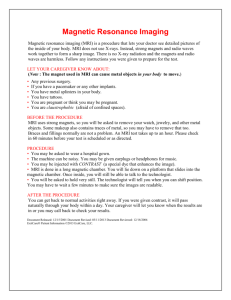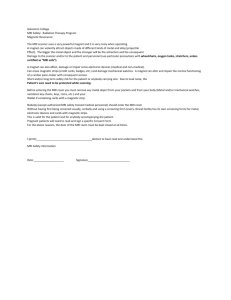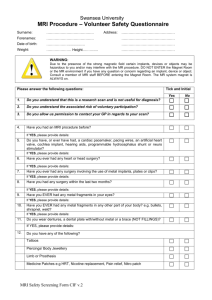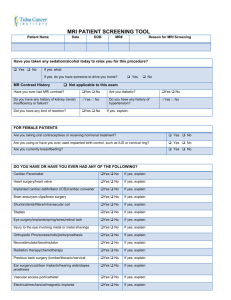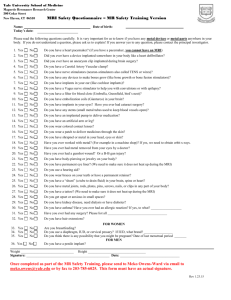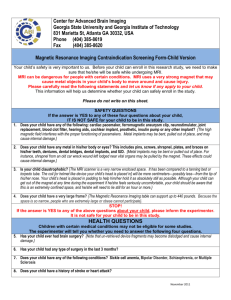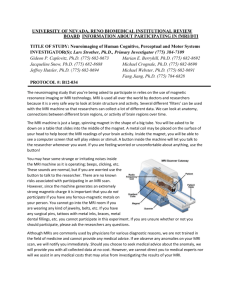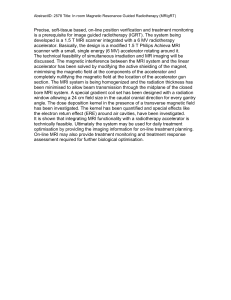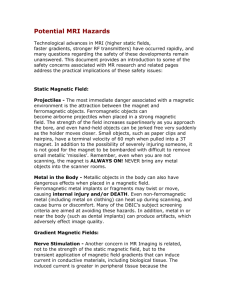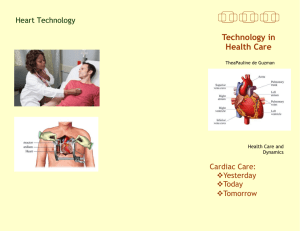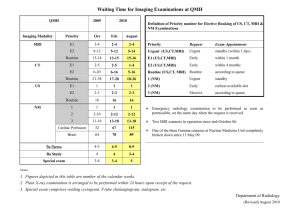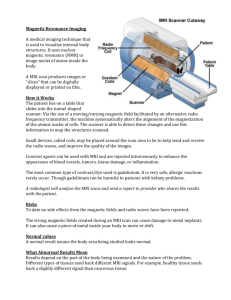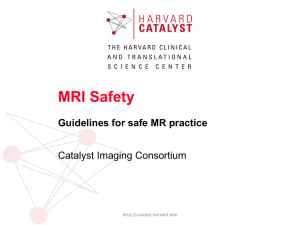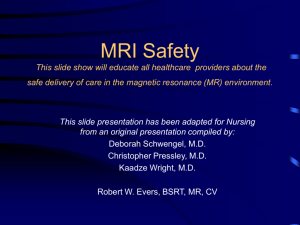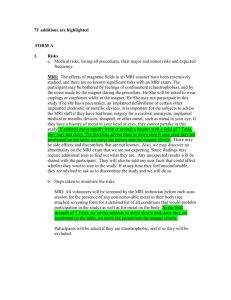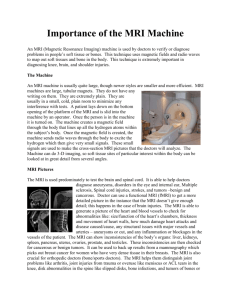Sample Ethics: Risks and Benefits Form
advertisement
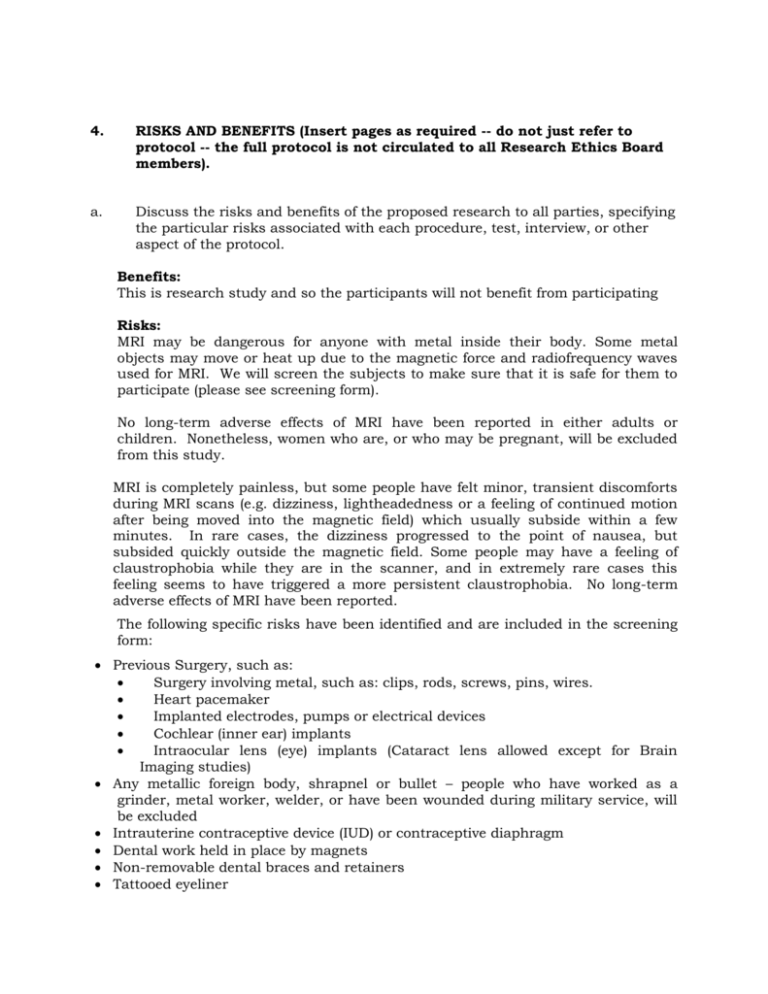
4. RISKS AND BENEFITS (Insert pages as required -- do not just refer to protocol -- the full protocol is not circulated to all Research Ethics Board members). a. Discuss the risks and benefits of the proposed research to all parties, specifying the particular risks associated with each procedure, test, interview, or other aspect of the protocol. Benefits: This is research study and so the participants will not benefit from participating Risks: MRI may be dangerous for anyone with metal inside their body. Some metal objects may move or heat up due to the magnetic force and radiofrequency waves used for MRI. We will screen the subjects to make sure that it is safe for them to participate (please see screening form). No long-term adverse effects of MRI have been reported in either adults or children. Nonetheless, women who are, or who may be pregnant, will be excluded from this study. MRI is completely painless, but some people have felt minor, transient discomforts during MRI scans (e.g. dizziness, lightheadedness or a feeling of continued motion after being moved into the magnetic field) which usually subside within a few minutes. In rare cases, the dizziness progressed to the point of nausea, but subsided quickly outside the magnetic field. Some people may have a feeling of claustrophobia while they are in the scanner, and in extremely rare cases this feeling seems to have triggered a more persistent claustrophobia. No long-term adverse effects of MRI have been reported. The following specific risks have been identified and are included in the screening form: Previous Surgery, such as: Surgery involving metal, such as: clips, rods, screws, pins, wires. Heart pacemaker Implanted electrodes, pumps or electrical devices Cochlear (inner ear) implants Intraocular lens (eye) implants (Cataract lens allowed except for Brain Imaging studies) Any metallic foreign body, shrapnel or bullet – people who have worked as a grinder, metal worker, welder, or have been wounded during military service, will be excluded Intrauterine contraceptive device (IUD) or contraceptive diaphragm Dental work held in place by magnets Non-removable dental braces and retainers Tattooed eyeliner Some tattoos (particularly recent tattoos and/or containing black ink) Non-removable metal jewellery (body piercing) b. According to the Tri-Council Policy Statement deception is not generally allowed in research. Please indicate if deception will be involved in this study. If yes, please justify its use and explain the debriefing procedures. No deception is involved with the proposed studies. c. Describe the procedures for preserving confidentiality of subjects or informants. Explain how written records, videotapes, recordings, questionnaires, and tests will be kept, and disposed of, after the study is completed. Indicate who is responsible for data monitoring and analysis. Describe any condition in which confidentiality or anonymity cannot be guaranteed or must be breached. Each participant will be assigned a subject number. This number will be used for all studies, should they choose to participate in other studies being carried out in the Queen’s MRI Facility. This common number is to enable records of total time exposed to the magnetic field to be maintained. This is to protect the subjects in the event that there should ever be any evidence found that exposure to magnetic fields of 3 tesla can pose a health risk. This will also enable the Facility to maintain a record of the safety checklists completed by a given person for each study in which they participate. This information will be stored in a locked filing cabinet, with files identified only by the subject number. A record of the subject number that has been assigned to each person will be maintained on a secure password-protected computer in the MRI Facility that is not connected to any networks. This file will not be accessible to any researchers including the PI, but can only be accessed by the MR Technologist and Facility Director for purposes of maintaining safety records. Upon request, the PI will be able to obtain a record of the subject names and corresponding subject numbers for those who participated in this study. The subject’s weight and age (not birth date) will be recorded. The person’s weight is required for safety monitoring during the MR imaging, because the MR system ensures that the amount of energy deposited in the body does not exceed FDA or Health Canada guidelines. The person’s age is required so that the group of volunteers can be characterized when reporting the results. The subject number, weight, and age, will be the only identifying information attached to the MR image data or notes taken during the study. The data will therefore be anonymous. The screening form and consent form that will be signed by the volunteer prior to participating, and the file linking the person’s name to the subject number, will be the only records linking the subject’s name to their assigned subject number. The screening and consent forms will be stored in a locked filing cabinet in the P.I.’s office. After five years these records will be disposed of by shredding. The P.I. will be responsible for all data monitoring and analysis.
